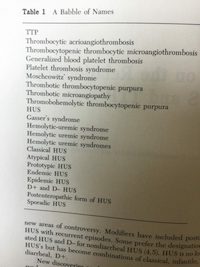Article No. 455

Dr Carla Nester is well known to the hundreds of aHUS families in the USA, and elsewhere, who have attended the famed biennial University of Iowa aHUS Families Conference. Carla is a highly regarded aHUS researcher and an author of published articles about aHUS.
Her latest article appeared on the “UPTODATE” website. The full article can be read at this link HERE.
Its title is “Thrombotic microangiopathies (TMAs) with acute kidney injury (AKI) in adults: CM-TMA and ST-HUS”.
So it is not about aHUS then?
Well HUS is mentioned but preceded by “ST” which stands for Shiga Toxin. Shiga Toxin is the cause of the TMA which is emitted by bacteria like Shigella Dysenteriae , or some strains of e.coli because it is the source of the damage to the lining of the small blood vessels.
So Shiga Toxin -HUS or ST-HUS takes ownership of the haemolytic uraemic syndrome name coined by Conrad von Gasser.
Why? Because the other of von Gasser’s syndromes, which became atypical HUS loses that historic link to become just a thrombotic microangiopathy which is caused by uncontrolled Complement activity resulting in damage of the linings of the blood vessels. Its TMA being “complement mediated”. CM-TMA.
Carla and her co author, Professor James N. George of the Oklahoma University, say emphatically that ST-HUS and CM-TMA are now their preferred terminologies.
They also recognise that “Certain terms based on older nomenclature continue to be used, and these may inadvertently propagate ambiguities in understanding disease physiology and management” . A worry! You could add to that the understanding of aHUS patients who are no longer aHUS patients. Who is going to tell them?
For nearly twenty years raising awareness of aHUS has been important to aHUS patients. Now they will be told they have something different.
It could be they have CM-TMA. CM-TMA does not roll off the tongue as easy as aHUS but it is more specific than atypical which created a vagueness. It does not, however, convey that the patient has experienced kidney failure, as uraemic does. If there was no evidential kidney injury then the patient did not have aHUS by definition.
So is it just changing the positioning of the vagueness of terms.
Whilst this one article cannot be that authoritative, it is part of a trend that aHUS Global Action picked up on over three years ago. Different clinicians creating their own preferred terms.
The purpose of the change is to help clinical reasoning arrive at a correct working diagnosis so that a correct treatment can be administered more quickly.
That remains to be seen but it is still going to a bumpy ride for patients whatever their disease is called. There will be implications.
Lots of current disease communities linked to aHUS will need to reconsider what to call themselves as future patients are not going to recognise, or be aware of, the term aHUS if these authors’ view prevail, because a link going back 66 years will be severed. It will no longer unite us.
Though calling them ST-TMA and CM-HUS, or even STHUS and CHUS, or even cHUS,, which would not be a great leap, and would be Global Action’s preferences. But patients have no voice in the matter.
aHUS Global Action has mooted the need for a TMA awareness day in the past , and has even suggested a date- 22 November. Perhaps 2022 might be year it is inaugurated. Maybe.
Meanwhile the 2021 aHUS Awareness Day is on 24 September.
But could it be the last one?

